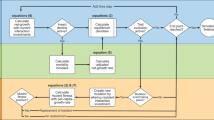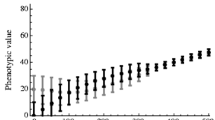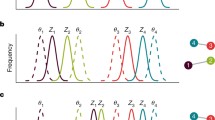Abstract
With current environmental changes, evolution can rescue declining populations, but what happens to their interacting species? Mutualistic interactions can help species sustain each other when their environment worsens. However, mutualism is often costly to maintain, and evolution might counter-select it when not profitable enough. We investigate how the evolution of the investment in a mutualistic interaction by a focal species affects the persistence of the system. Specifically, using eco-evolutionary dynamics, we study the evolution of the focal species investment in the mutualistic interaction of a focal species (e.g. plant attractiveness via flower or nectar production for pollinators or carbon exudate for mycorrhizal fungi), and how it is affected by the decline of the partner population with which it is interacting. We assume an allocation trade-off so that investment in the mutualistic interaction reduces the species intrinsic growth rate. First, we investigate how evolution changes species persistence, biomass production, and the intensity of the mutualistic interaction. We show that concave trade-offs allow evolutionary convergence to stable coexistence. We next assume an external disturbance that decreases the partner population by lowering its intrinsic growth rate. Such declines result in the evolution of lower investment of the focal species in the mutualistic interaction, which eventually leads to the extinction of the partner species. With asymmetric mutualism favouring the partner, the evolutionary disappearance of the mutualistic interaction is delayed. Our results suggest that evolution may account for the current collapse of some mutualistic systems like plant-pollinator ones, and that restoration attempts should be enforced early enough to prevent potential negative effects driven by evolution.





Similar content being viewed by others
Availability of data and materials
Not applicable.
Code availability
The scripts used to produce the data and Figs. 2, 4, 5 and figure C1 and D1 of the supplementary materials can be found in Zenodo ( https://doi.org/10.5281/zenodo.5552426.)
References
Astegiano J, Massol F, Vidal MM, Cheptou P-O Jr, Guimarães PR (2015) The robustness of plant-pollinator assemblages: linking plant interaction patterns and sensitivity to pollinator loss. PLoS ONE 10:e0117243. https://doi.org/10.1371/journal.pone.0117243
Biesmeijer JC, Roberts SPM, Reemer M, Ohlemüller R, Edwards M, Peeters T, Schaffers AP, Potts SG, Kleukers R, Thomas CD, Settele J, Kunin WE (2006) Parallel declines in pollinators and insect-pollinated plants in Britain and the Netherlands. Science 313:351–354. https://doi.org/10.1126/science.1127863
Bodbyl Roels SA, Kelly JK (2011) Rapid evolution caused by pollinator loss in Mimulus Guttatus. Evolution 65:2541–2552. https://doi.org/10.1111/j.1558-5646.2011.01326.x
Carlson SM, Cunningham CJ, Westley PAH (2014) Evolutionary rescue in a changing world. Trends Ecol Evol 29:521–530. https://doi.org/10.1016/j.tree.2014.06.005
Cheptou P, Massol F (2009) Pollination fluctuations drive evolutionary syndromes linking dispersal and mating system. Am Nat 174:46–55. https://doi.org/10.1086/599303
Christiansen FB (1991) On Conditions for evolutionary stability for a continuously varying character. Am Nat 138:37–50
Darwin C (1877) On the various contrivances by which British and foreign orchids are fertilised by insects, and on the good effects of intercrossing. John Murray, London.
De Mazancourt C, Schwartz MW (2010) A resource ratio theory of cooperation. Ecol Lett 13:349–359. https://doi.org/10.1111/j.1461-0248.2009.01431.x
Dercole F, Ferriere R, Rinaldi S (2002) Ecological bistability and evolutionary reversals under asymmetrical competition. Evolution 56:1081–1090. https://doi.org/10.1111/j.0014-3820.2002.tb01422.x
Dieckmann U, Ferrière R (2004) Adaptive dynamics and evolving biodiversity. Evolutionary conservation biology. Cambridge University Press, Cambridge, pp 188–224
Dieckmann U, Law R (1996) The dynamical theory of coevolution: a derivation from stochastic ecological processes. J Math Biol 34:579–612. https://doi.org/10.1007/BF02409751
Dieckmann U, Marrow P, Law R (1995) Evolutionary cycling in predator-prey interactions: population dynamics and the red queen. J Theor Biol 176:91–102. https://doi.org/10.1006/jtbi.1995.0179
Egerton-Warburton LM, Johnson NC, Allen EB (2007) Mycorrhizal community dynamics following nitrogen fertilization: a cross-site test in five grasslands. Ecol Monogr 77:527–544. https://doi.org/10.1890/06-1772.1
Ferriere R, Legendre S (2013) Eco-evolutionary feedbacks, adaptive dynamics and evolutionary rescue theory. Phil Trans R Soc B 368:20120081. https://doi.org/10.1098/rstb.2012.0081
Ferriere R, Bronstein JL, Rinaldi S, Law R, Gauduchon M (2002) Cheating and the evolutionary stability of mutualisms. Proc R Soc Lond B Biol Sci 269:773–780. https://doi.org/10.1098/rspb.2001.1900
Fishman MA, Hadany L (2010) Plant–pollinator population dynamics. Theor Popul Biol 78:270–277. https://doi.org/10.1016/j.tpb.2010.08.002
Georgelin E, Loeuille N (2016) Evolutionary response of plant interaction traits to nutrient enrichment modifies the assembly and structure of antagonistic-mutualistic communities. J Ecol 104:193–205. https://doi.org/10.1111/1365-2745.12485
Geritz SAH, Kisdi E, Mesze G, Metz JAJ (1998) Evolutionarily singular strategies and the adaptive growth and branching of the evolutionary tree. Evol Ecol 12:35–57. https://doi.org/10.1023/A:1006554906681
Gervasi DDL, Schiestl FP (2017) Real-time divergent evolution in plants driven by pollinators. Nat Commun 8:14691. https://doi.org/10.1038/ncomms14691
Goh BS (1976) Global stability in two species interactions. J Math Biol 3:313–318. https://doi.org/10.1007/BF00275063
Goh BS (1979) Stability in models of mutualism. Am Nat 113:261–275
Holland JN, DeAngelis DL (2010) A consumer–resource approach to the density-dependent population dynamics of mutualism. Ecology 91:1286–1295. https://doi.org/10.1890/09-1163.1
Hopkins R, Rausher MD (2012) Pollinator-mediated selection on flower color allele drives reinforcement. Science 335:1090–1092. https://doi.org/10.1126/science.1215198
Johnson NC, Rowland DL, Corkidi L, Egerton-Warburton LM, Allen EB (2003) Nitrogen enrichment alters mycorrhizal allocation at five mesic to semiarid grasslands. Ecology 84:1895–1908. https://doi.org/10.1890/0012-9658(2003)084[1895:NEAMAA]2.0.CO;2
Jordano P, Forget P-M, Lambert JE, Böhning-Gaese K, Traveset A, Wright SJ (2010) Frugivores and seed dispersal: mechanisms and consequences for biodiversity of a key ecological interaction. Biol Lett rsbl20100986. https://doi.org/10.1098/rsbl.2010.0986
Lepers C, Dufay M, Billiard S (2014) How does pollination mutualism affect the evolution of prior self-fertilization? A model. Evolution 68:3581–3598. https://doi.org/10.1111/evo.12533
Loeuille N (2019) Eco-evolutionary dynamics in a disturbed world: implications for the maintenance of ecological networks. F1000Research 8. https://doi.org/10.12688/f1000research.15629.1
Marrow P, Dieckmann U, Law R (1996) Evolutionary dynamics of predator-prey systems: an ecological perspective. J Math Biol 34:556–578. https://doi.org/10.1007/BF02409750
Nijjer S, Rogers WE, Lee C-TA, Siemann E (2008) The effects of soil biota and fertilization on the success of Sapium sebiferum. Appl Soil Ecol 38:1–11. https://doi.org/10.1016/j.apsoil.2007.08.002
Obeso JR (2002) The costs of reproduction in plants. New Phytol 155:321–348. https://doi.org/10.1046/j.1469-8137.2002.00477.x
Parmesan C (2006) Ecological and evolutionary responses to recent climate change. Annu Rev Ecol Evol Syst 37:637–669. https://doi.org/10.1146/annurev.ecolsys.37.091305.110100
Parvinen K (2005) Evolutionary suicide. Acta Biotheor 53:241–264. https://doi.org/10.1007/s10441-005-2531-5
Potts SG, Biesmeijer JC, Kremen C, Neumann P, Schweiger O, Kunin WE (2010) Global pollinator declines: trends, impacts and drivers. Trends Ecol Evol 25:345–353. https://doi.org/10.1016/j.tree.2010.01.007
Reekie E, Bazzaz FA (2011) Reproductive allocation in plants. Elsevier
Rohr RP, Saavedra S, Bascompte J (2014) On the structural stability of mutualistic systems. Science 345:1253497. https://doi.org/10.1126/science.1253497
Saavedra S, Rohr RP, Olesen JM, Bascompte J (2016) Nested species interactions promote feasibility over stability during the assembly of a pollinator community. Ecol Evol 6:997–1007. https://doi.org/10.1002/ece3.1930
Scheffer M, Carpenter SR (2003) Catastrophic regime shifts in ecosystems: linking theory to observation. Trends Ecol Evol 18:648–656. https://doi.org/10.1016/j.tree.2003.09.002
Thébault E, Fontaine C (2010) Stability of ecological communities and the architecture of mutualistic and trophic networks. Science 329:853–856. https://doi.org/10.1126/science.1188321
Thomann M, Imbert E, Devaux C, Cheptou P-O (2013) Flowering plants under global pollinator decline. Trends Plant Sci 18:353–359. https://doi.org/10.1016/j.tplants.2013.04.002
Toby Kiers E, Palmer TM, Ives AR, Bruno JF, Bronstein JL (2010) Mutualisms in a changing world: an evolutionary perspective. Ecol Lett 13:1459–1474. https://doi.org/10.1111/j.1461-0248.2010.01538.x
Tylianakis JM, Didham RK, Bascompte J, Wardle DA (2008) Global change and species interactions in terrestrial ecosystems. Ecol Lett 11:1351–1363. https://doi.org/10.1111/j.1461-0248.2008.01250.x
Valdovinos FS, Brosi BJ, Briggs HM, Moisset de Espanés P, Ramos-Jiliberto R, Martinez ND (2016) Niche partitioning due to adaptive foraging reverses effects of nestedness and connectance on pollination network stability. Ecol Lett 19:1277–1286. https://doi.org/10.1111/ele.12664
Willmer P (2011a) Pollination and Floral Ecology. Princeton University Press
Willmer P (2011b) Rewards and costs: the environmental economics of pollination. In: Pollination and Floral Ecology. Princeton University Press, pp 234–257
Wilson GWT, Rice CW, Rillig MC, Springer A, Hartnett DC (2009) Soil aggregation and carbon sequestration are tightly correlated with the abundance of arbuscular mycorrhizal fungi: results from long-term field experiments. Ecol Lett 12:452–461. https://doi.org/10.1111/j.1461-0248.2009.01303.x
Acknowledgements
Nicolas Loeuille and Avril Weinbach would like to acknowledge the French National Research Agency (ANR) for funding, as well as the École Normale Supérieure de Lyon. Rudolf P. Rohr acknowledges funding from the Swiss National Science Foundation. Authors would also like to thank Sylvain Billiard and two anonymous reviewers for insightful comments on the present manuscript via the Peer Community In (PCI) reviewing process. The version 5 recommended can be found online on bioRxiv (https://doi.org/10.1101/570580) and the recommendation on the Peer Community in Ecology website (https://doi.org/10.24072/pci.ecology.100089).
Funding
Nicolas Loeuille and Avril Weinbach were supported by the French National Research Agency (ANR) through project ARSENIC (grant no. 14-CE02-0012). Avril Weinbach was additionally supported by a doctoral scholarship from the École Normale Supérieure de Lyon. Rudolf P. Rohr acknowledges funding from the Swiss National Science Foundation, Project grant no. 31003A_182386.
Author information
Authors and Affiliations
Contributions
Nicolas Loeuille and Rudolf P. Rohr designed the model. Avril Weinbach performed the analysis with Rudolf P. Rohr All authors contributed to writing the article, while the first draft was written by Avril Weinbach.
Corresponding author
Ethics declarations
Conflict of interest
The authors of this manuscript declare that they have no financial conflict of interest with the content of this article.
Ethics approval
Not applicable.
Consent to participate
Not applicable.
Consent for publication
Not applicable.
Additional information
Publisher's Note
Springer Nature remains neutral with regard to jurisdictional claims in published maps and institutional affiliations.
Supplementary Information
Below is the link to the electronic supplementary material.
Rights and permissions
About this article
Cite this article
Weinbach, A., Loeuille, N. & Rohr, R.P. Eco-evolutionary dynamics further weakens mutualistic interaction and coexistence under population decline. Evol Ecol 36, 373–387 (2022). https://doi.org/10.1007/s10682-022-10176-7
Received:
Accepted:
Published:
Issue Date:
DOI: https://doi.org/10.1007/s10682-022-10176-7




